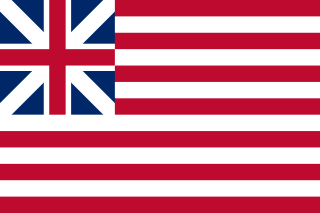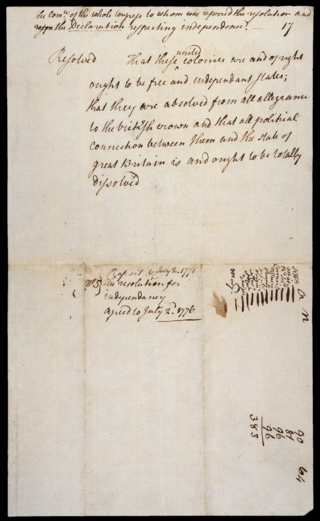Related Research Articles

The Articles of Confederation and Perpetual Union was an agreement among the 13 states of the United States, formerly the Thirteen Colonies, that served as the nation's first frame of government. It was debated by the Second Continental Congress at Independence Hall in Philadelphia between July 1776 and November 1777, and finalized by the Congress on November 15, 1777. It came into force on March 1, 1781, after being ratified by all 13 colonial states. A guiding principle of the Articles was the establishment and preservation of the independence and sovereignty of the states. The Articles consciously established a weak central government, affording it only those powers the former colonies had recognized as belonging to king and parliament. The document provided clearly written rules for how the states' league of friendship, known as the Perpetual Union, would be organized.

The Constitution of the United States is the supreme law of the United States of America. It superseded the Articles of Confederation, the nation's first constitution, in 1789. Originally comprising seven articles, it delineates the national frame and constraints of government. The Constitution's first three articles embody the doctrine of the separation of powers, whereby the federal government is divided into three branches: the legislative, consisting of the bicameral Congress ; the executive, consisting of the president and subordinate officers ; and the judicial, consisting of the Supreme Court and other federal courts. Article IV, Article V, and Article VI embody concepts of federalism, describing the rights and responsibilities of state governments, the states in relationship to the federal government, and the shared process of constitutional amendment. Article VII establishes the procedure subsequently used by the 13 states to ratify it. The Constitution of the United States is the oldest and longest-standing written and codified national constitution in force in the world today.

Article One of the United States Constitution establishes the legislative branch of the federal government, the United States Congress. Under Article One, Congress is a bicameral legislature consisting of the House of Representatives and the Senate. Article One grants Congress various enumerated powers and the ability to pass laws "necessary and proper" to carry out those powers. Article One also establishes the procedures for passing a bill and places various limits on the powers of Congress and the states from abusing their powers.

The Continental Congress was a series of legislative bodies, with some executive function, for the thirteen colonies of Great Britain in North America, and the newly declared United States before, during, and after the American Revolutionary War. The Continental Congress refers to both the First and Second Congresses of 1774–1781 and at the time, also described the Congress of the Confederation of 1781–1789. The Confederation Congress operated as the first federal government until being replaced following ratification of the U.S. Constitution. The Congress met predominantly at Independence Hall in Philadelphia, though it was relocated temporarily on several occasions during the Revolutionary War and the fall of Philadelphia.

As a result of the American Revolution, the thirteen British colonies emerged as a newly independent nation, the United States of America, between 1776 and 1789. Fighting in the American Revolutionary War started between colonial militias and the British Army in 1775. The Second Continental Congress issued the Declaration of Independence on July 4, 1776. The Articles of Confederation were ratified in 1781 to form the Congress of the Confederation. Under the leadership of General George Washington, the Continental Army and Navy defeated the British military, securing the independence of the thirteen colonies. The Confederation period continued until 1789, when the states replaced the Articles of Confederation with the Constitution of the United States, which remains the fundamental governing law of the United States.

The Standing Committee of the National People's Congress (NPCSC) is the permanent body of the National People's Congress (NPC), the national legislature of China. Although the parent NPC officially has superiority over the Standing Committee, and certain authorities are not delegated, the Standing Committee is generally viewed to have more de facto power, as the NPC convenes only once a year for two weeks, leaving its Standing Committee the only body that regularly drafts and approves decisions and laws.

The president of the United States in Congress Assembled, known unofficially as the president of the Continental Congress and later as president of the Congress of the Confederation, was the presiding officer of the Continental Congress, the convention of delegates that assembled in Philadelphia as the first transitional national government of the United States during the American Revolution. The president was a member of Congress elected by the other delegates to serve as a neutral discussion moderator during meetings of Congress. Designed to be a largely ceremonial position without much influence, the office was unrelated to the later office of President of the United States.

The Second Continental Congress was the late-18th-century meeting of delegates from the Thirteen Colonies that united in support of the American Revolution and its associated Revolutionary War, which established American independence from the British Empire. The Congress created a new country that it first named the United Colonies, and in 1776, renamed the United States of America. The Congress began convening in Philadelphia, on May 10, 1775, with representatives from 12 of the 13 colonies, after the Battles of Lexington and Concord.

The United States Constitution has served as the supreme law of the United States since taking effect in 1789. The document was written at the 1787 Philadelphia Convention and was ratified through a series of state conventions held in 1787 and 1788. Since 1789, the Constitution has been amended twenty-seven times; particularly important amendments include the ten amendments of the United States Bill of Rights and the three Reconstruction Amendments.

The Founding Fathers of the United States, commonly referred to simply as the Founding Fathers, were a group of late 18th century American revolutionary leaders who united the Thirteen Colonies, oversaw the War of Independence from Great Britain, established the United States, and crafted a framework of government for the new nation.

The Constitutional Convention took place in Philadelphia from May 25 to September 17, 1787. Although the convention was intended to revise the league of states and first system of government under the Articles of Confederation, the intention from the outset of many of its proponents, chief among them James Madison of Virginia and Alexander Hamilton of New York, was to create a new Frame of Government rather than fix the existing one. The delegates elected George Washington of Virginia, former commanding general of the Continental Army in the late American Revolutionary War (1775–1783) and proponent of a stronger national government, to become President of the convention. The result of the convention was the creation of the Constitution of the United States, placing the Convention among the most significant events in American history.

The Lee Resolution, also known as "The Resolution for Independence", was the formal assertion passed by the Second Continental Congress on July 2, 1776, which resolved that the Thirteen Colonies, then referred to as the United Colonies, were "free and independent States" and separate from the British Empire, which created what became the United States of America. News of this act was published that evening in The Pennsylvania Evening Post and the next day in The Pennsylvania Gazette. The Declaration of Independence officially announced and explained the case for independence and was approved two days later, on July 4, 1776.

The Model Treaty, or the Plan of 1776, was a template for commercial treaties that the United States planned to make with foreign powers during the American Revolution against Great Britain. It was drafted by the Continental Congress to secure economic resources for the war effort, and to serve as an idealistic guide for future relations and treaties between the new American government and other nations. The Model Treaty thus marked the revolution's turning point towards seeking independence, and is subsequently considered a milestone in U.S. foreign relations.

The Congress of the Confederation, or the Confederation Congress, formally referred to as the United States in Congress Assembled, was the governing body of the United States from March 1, 1781, until March 3, 1789, during the Confederation period. A unicameral body with legislative and executive function, it was composed of delegates appointed by the legislatures of the several states. Each state delegation had one vote. The Congress was created by the Articles of Confederation and Perpetual Union upon its ratification in 1781, formally replacing the Second Continental Congress.

The drafting of the Constitution of the United States began on May 25, 1787, when the Constitutional Convention met for the first time with a quorum at the Pennsylvania State House in Philadelphia, Pennsylvania to revise the Articles of Confederation. It ended on September 17, 1787, the day the Frame of Government drafted by the convention's delegates to replace the Articles was adopted and signed. The ratification process for the Constitution began that day, and ended when the final state, Rhode Island, ratified it on May 29, 1790.

The Confederation period was the era of United States history in the 1780s after the American Revolution and prior to the ratification of the United States Constitution. In 1781, the United States ratified the Articles of Confederation and Perpetual Union and prevailed in the Battle of Yorktown, the last major land battle between British and American Continental forces in the American Revolutionary War. American independence was confirmed with the 1783 signing of the Treaty of Paris. The fledgling United States faced several challenges, many of which stemmed from the lack of a strong national government and unified political culture. The period ended in 1789 following the ratification of the United States Constitution, which established a new, more powerful, national government.
The Ordinance of 1784 called for the land in the recently created United States which was located west of the Appalachian Mountains, north of the Ohio River and east of the Mississippi River to be divided into separate states.

Ratification Day in the United States is the anniversary of the congressional proclamation of the ratification of the Treaty of Paris, on January 14, 1784, at the Maryland State House in Annapolis, Maryland, by the Confederation Congress, which marked the official end of the American Revolutionary War.
Admission to the Union is provided by the Admissions Clause of the United States Constitution in Article IV, Section 3, Clause 1, which authorizes the United States Congress to admit new states into the Union beyond the thirteen states that already existed when the Constitution came into effect. The Constitution went into effect on June 21, 1788, in the nine states that had ratified it, and the U.S. federal government began operations under it on March 4, 1789, when it was in effect in 11 out of the 13 states. Since then, 37 states have been admitted into the Union. Each new state has been admitted on an equal footing with those already in existence.

The National People's Congress (NPC) is the highest organ of state power of the People's Republic of China. The NPC is the only branch of government in China, and per the principle of unified power, all state organs from the State Council to the Supreme People's Court (SPC) are subservient to it. With 2,980 members in 2023, it is the largest legislative body in the world. The NPC is elected for a term of five years. It holds annual sessions every spring, usually lasting from 10 to 14 days, in the Great Hall of the People on the west side of Tiananmen Square in Beijing.
References
- ↑ Mount, Steve. "Constitutional Topic: Articles of Confederation". USConstitution.net. Retrieved 22 June 2012.
- 1 2 "Article 10 Summary—The Committee of the States". The Articles of Confederation (1781-1789). sparknotes.com. Retrieved 22 June 2012.
- ↑ Frederick Ellis, ed. (1821). The Autobiography of Thomas Jefferson. p. 49.
- ↑ "Why the Articles of Confederation failed". Originalism and Discover the Founding Principles. discoveringthefoundingprinciples.com. Retrieved 22 June 2012.